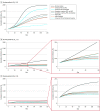Clinical Outcomes, Costs, and Cost-effectiveness of Strategies for Adults Experiencing Sheltered Homelessness During the COVID-19 Pandemic
- PMID: 33351082
- PMCID: PMC7756240
- DOI: 10.1001/jamanetworkopen.2020.28195
Clinical Outcomes, Costs, and Cost-effectiveness of Strategies for Adults Experiencing Sheltered Homelessness During the COVID-19 Pandemic
Abstract
Importance: Approximately 356 000 people stay in homeless shelters nightly in the United States. They have high risk of contracting coronavirus disease 2019 (COVID-19).
Objective: To assess the estimated clinical outcomes, costs, and cost-effectiveness associated with strategies for COVID-19 management among adults experiencing sheltered homelessness.
Design, setting, and participants: This decision analytic model used a simulated cohort of 2258 adults residing in homeless shelters in Boston, Massachusetts. Cohort characteristics and costs were adapted from Boston Health Care for the Homeless Program. Disease progression, transmission, and outcomes data were taken from published literature and national databases. Surging, growing, and slowing epidemics (effective reproduction numbers [Re], 2.6, 1.3, and 0.9, respectively) were examined. Costs were from a health care sector perspective, and the time horizon was 4 months, from April to August 2020.
Exposures: Daily symptom screening with polymerase chain reaction (PCR) testing of individuals with positive symptom screening results, universal PCR testing every 2 weeks, hospital-based COVID-19 care, alternative care sites (ACSs) for mild or moderate COVID-19, and temporary housing were each compared with no intervention.
Main outcomes and measures: Cumulative infections and hospital-days, costs to the health care sector (US dollars), and cost-effectiveness, as incremental cost per case of COVID-19 prevented.
Results: The simulated population of 2258 sheltered homeless adults had a mean (SD) age of 42.6 (9.04) years. Compared with no intervention, daily symptom screening with ACSs for pending tests or confirmed COVID-19 and mild or moderate disease was associated with 37% fewer infections (1954 vs 1239) and 46% lower costs ($6.10 million vs $3.27 million) at an Re of 2.6, 75% fewer infections (538 vs 137) and 72% lower costs ($1.46 million vs $0.41 million) at an Re of 1.3, and 51% fewer infections (174 vs 85) and 51% lower costs ($0.54 million vs $0.26 million) at an Re of 0.9. Adding PCR testing every 2 weeks was associated with a further decrease in infections; incremental cost per case prevented was $1000 at an Re of 2.6, $27 000 at an Re of 1.3, and $71 000 at an Re of 0.9. Temporary housing with PCR every 2 weeks was most effective but substantially more expensive than other options. Compared with no intervention, temporary housing with PCR every 2 weeks was associated with 81% fewer infections (376) and 542% higher costs ($39.12 million) at an Re of 2.6, 82% fewer infections (95) and 2568% higher costs ($38.97 million) at an Re of 1.3, and 59% fewer infections (71) and 7114% higher costs ($38.94 million) at an Re of 0.9. Results were sensitive to cost and sensitivity of PCR and ACS efficacy in preventing transmission.
Conclusions and relevance: In this modeling study of simulated adults living in homeless shelters, daily symptom screening and ACSs were associated with fewer severe acute respiratory syndrome coronavirus 2 (SARS-CoV-2) infections and decreased costs compared with no intervention. In a modeled surging epidemic, adding universal PCR testing every 2 weeks was associated with further decrease in SARS-CoV-2 infections at modest incremental cost and should be considered during future surges.
Conflict of interest statement
Figures



Update of
-
Clinical Outcomes, Costs, and Cost-effectiveness of Strategies for People Experiencing Sheltered Homelessness During the COVID-19 Pandemic.medRxiv [Preprint]. 2020 Oct 20:2020.08.07.20170498. doi: 10.1101/2020.08.07.20170498. medRxiv. 2020. Update in: JAMA Netw Open. 2020 Dec 1;3(12):e2028195. doi: 10.1001/jamanetworkopen.2020.28195. PMID: 32817967 Free PMC article. Updated. Preprint.
References
-
- Henry M, Bishop K, de Sousa T, Shivji A, Watt R. The 2017 Annual Homeless Assessment Report (AHAR) to Congress part 2: estimates of homelessness in the United States. US Department of Housing and Urban Development. Published October 2018. Accessed November 19, 2020. https://www.hudexchange.info/resource/5769/2017-ahar-part-2-estimates-of...
-
- Henry M, Watt R, Mahathey A, Ouellette J, Sitler A. The 2019 Annual Homeless Assessment Report (AHAR) to Congress, part 1: point-in-time estimates of homelessness. US Department of Housing and Urban Development. Published January 2020. Accessed November 19, 2020. https://www.hudexchange.info/resource/5948/2019-ahar-part-1-pit-estimate...
-
- US Centers for Disease Control and Prevention Interim guidance for homeless service providers to plan and respond to coronavirus disease 2019 (COVID-19). Published February 11, 2020. Accessed July 29, 2020. https://www.cdc.gov/coronavirus/2019-ncov/community/homeless-shelters/pl...
-
- Jolicoeur L. Testing at Worcester homeless shelter finds 43% positive for coronavirus. WBUR. Published May 20, 2020. Accessed July 29, 2020. https://www.wbur.org/news/2020/04/17/worcester-homeless-population-covid...
Publication types
MeSH terms
Grants and funding
LinkOut - more resources
Full Text Sources
Medical
Miscellaneous

